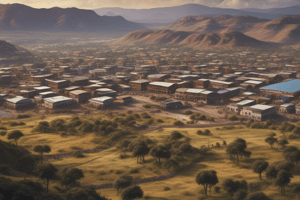Podcast
Questions and Answers
What events led to the peak of opposition against Haile Selassie's regime in February 1974?
What events led to the peak of opposition against Haile Selassie's regime in February 1974?
Growing strikes, protests, and demonstrations against the imperial regime.
Which regions in Ethiopia were affected by serious famines from 1958 to 1974?
Which regions in Ethiopia were affected by serious famines from 1958 to 1974?
Tigray in 1958/59, Wag-Lasta in 1956/66, and Wallo province in 1972/73.
How did the urban population of Ethiopia suffer during this period?
How did the urban population of Ethiopia suffer during this period?
They were suffering from inflation and corrupt administration.
Who made the devastating famine in Ethiopia known to the international community?
Who made the devastating famine in Ethiopia known to the international community?
Which sectors of society actively participated in the popular uprisings at the beginning of 1974?
Which sectors of society actively participated in the popular uprisings at the beginning of 1974?
What event sparked the first serious act towards revolution in Ethiopia in January 1974?
What event sparked the first serious act towards revolution in Ethiopia in January 1974?
What was the Ethiopian Teachers Association's opposition to on February 18, 1974?
What was the Ethiopian Teachers Association's opposition to on February 18, 1974?
What were some of the demands presented by the Confederation of Ethiopian Labour Union to Prime Minister Endalkachew Mekonen?
What were some of the demands presented by the Confederation of Ethiopian Labour Union to Prime Minister Endalkachew Mekonen?
What slogan was introduced by the Derg after its establishment on June 28, 1974?
What slogan was introduced by the Derg after its establishment on June 28, 1974?
Who became the new Chairman of the Derg and head of state on November 24, 1974?
Who became the new Chairman of the Derg and head of state on November 24, 1974?
Study Notes
The Road to Revolution in Ethiopia
- In January 1974, the Negelle army mutinied, demanding a pay increase and better working conditions, sparking a wave of protests across the country.
- The Ethiopian Teachers Association opposed the new educational reform program, known as the Sector Review, on 18 February 1974, accompanied by students and parents.
- Taxi drivers went on strike the same day, protesting the 50% rise in petrol prices.
- The Confederation of Ethiopian Labour Union (CELU) presented a list of demands to Prime Minister Endalkachew Mekonen, including new labour legislation, freedom of organization, pension and wage increase, job security, and free education for all.
- The Muslim community demonstrated against age-old discrimination they suffered.
The Rise of the Derg
- The Coordinating Committee of the Armed Forces (AFCC), commonly known as Derg, was set up from the Armed forces, police, and territorial Army.
- The Derg acted as a de facto government and began to exercise power and take action, detaining high-ranking officials of the imperial regime, including Prime Minister Endalkachew.
- Lij Mikael Emiru became the new prime minister, and the Derg introduced its motto, "Ethiopia Tikdem".
- On 12 September 1974, the Derg deposed Haile Selassie and transformed itself into a Provisional Military Administration Council (PMAC).
- Lieutenant General Aman Mikael Andom became the first chairman of PMAC, with Major Mengistu Haile Mariam and Major Atnafu Abate as his vice-chairmen.
The Ethiopian Revolution and the Fall of the Monarchy
- The last two decades of Haile Selassie's reign witnessed growing opposition to his regime, reaching its peak in February 1974.
- The country's social, economic, and political situations worsened, leading to a series of strikes, protests, and demonstrations against the imperial regime.
- Rural people suffered from natural and man-made famines, with almost all administrative regions of Ethiopia affected from 1958 to 1974.
- The urban population suffered from inflation and corrupt administration.
- A devastating famine was made public to the international community by Ethiopian students and a documentary film produced by Jonathan Dimbleby.
- At the beginning of 1974, the situation in Ethiopia was ripe for revolution, with popular uprisings becoming widespread, particularly in urban centers.
Studying That Suits You
Use AI to generate personalized quizzes and flashcards to suit your learning preferences.
Description
Learn about the events surrounding the Ethiopian Revolution, including the deposition of the Emperor Haile Selassie and the emergence of the Derg. Explore the social, economic, and political turmoil that led to widespread opposition and protests against the imperial regime.




